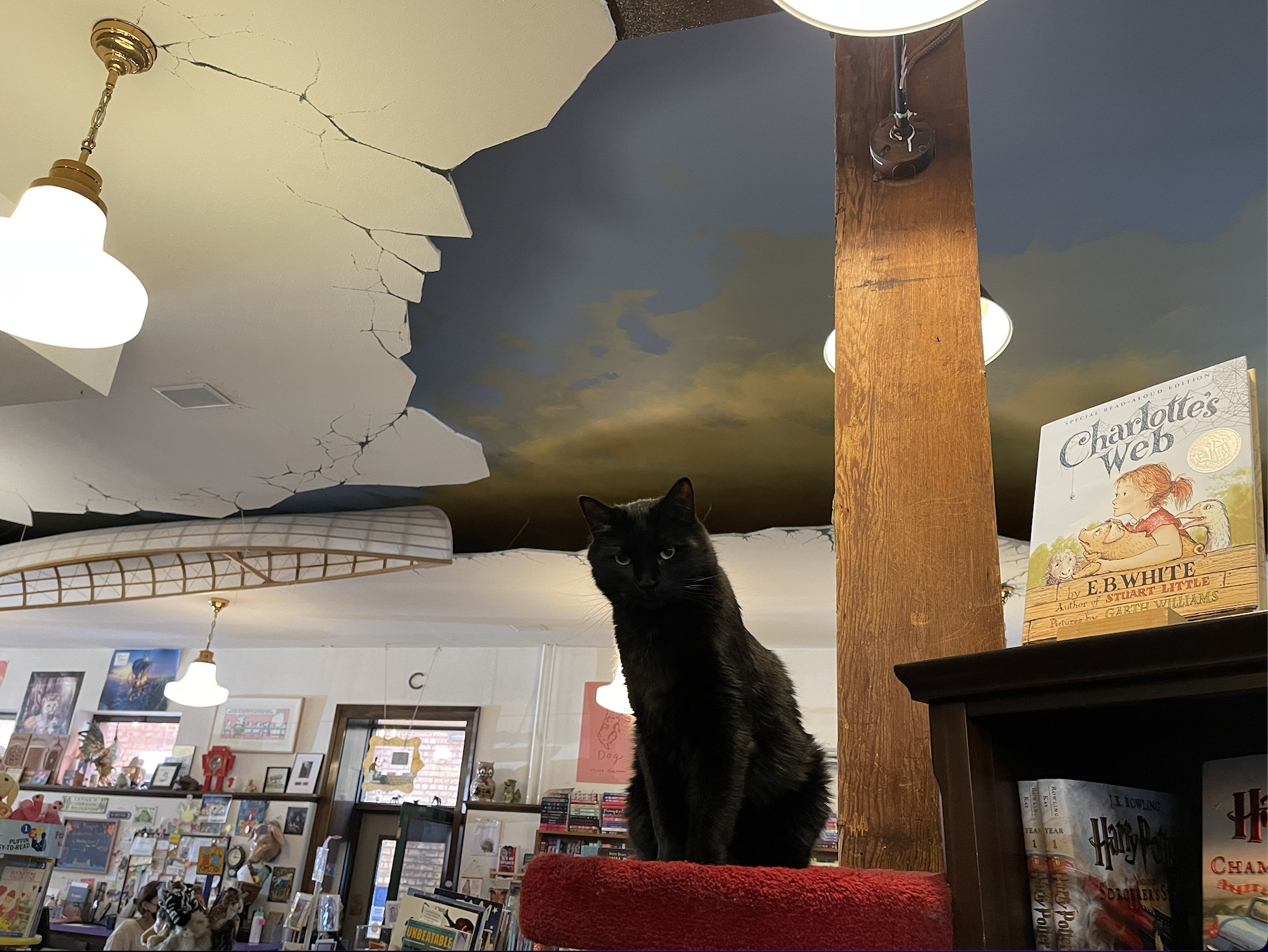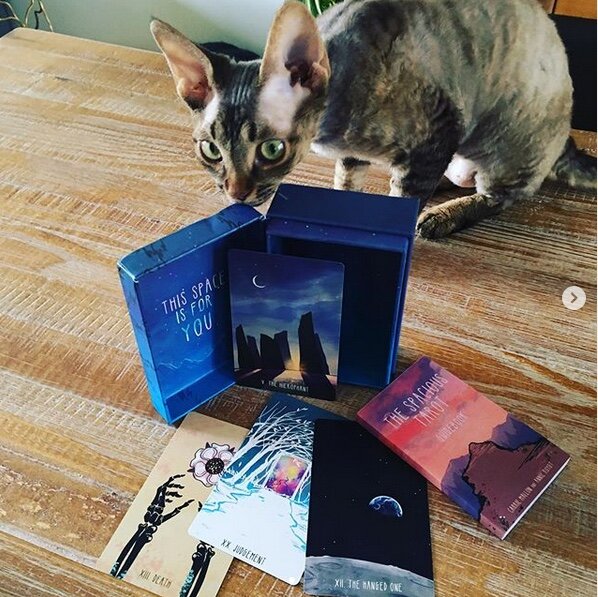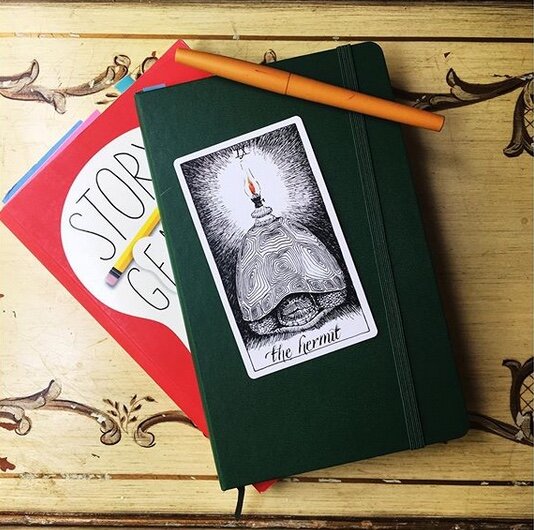“If there is enchantment, it lies not in the potter’s wheel, but the potter.”
To celebrate autumn and the launch of my first public tarot for writers workshop this October, I'm dropping a little spell for clarity into your inboxes today in the form of a tarot spread that you can use for yourself and your protagonist.
Oh, how I love autumn. It feels like I felt when I took the above picture: I wandered into my favorite children's bookstore last week - Wild Rumpus in Minneapolis - and the store's cat graciously allowed me to take this photo. I felt like I was Meg Ryan in her Shop Around the Corner (ahem, You've Got Mail). I pretty much live for discovering magical places that exist in our earthly realm. Bookstores, the backstages of black box theaters, cobblestoned alleyways filled with unexpected strains of a violin's scales, secret hideaways beneath trees, the perfect book in a Free Little Library....you catch my drift.
But sometimes I need a reminder that the magic I'm always looking for outside me has its source within me.
In fact, the only reason I'm able to find and appreciate magic on Earth is because like calls to like: the magic within me recognizes its kin outside the confines of my body. Writing is the bridge that allows me to travel more frequently between these two mystical realms.
I cherish that Lloyd Alexander quote above, not least of which because I and the writers I know and work with all seem to be refocusing our energy on orienting toward our relationship to our work, versus a focus on outcomes.
We write because you need words for a spell. We write because everyone knows that if you don't use your magical powers, you either lose them or they eat you alive.
When someone's work strikes a chord with readers, when it has that luscious emotional resonance that makes you catch your breath, when it gets the honor of the dog-ear, the underline, the worn cover - it's all you, writer. No one can teach you that. There is no formula. You can't pay for it. You can't fake it. But you can FIND it. In fact, it's already inside you.
This means that the whole point of reading blog posts like this one is to discover tools and resources that will help you access your inner magic and draw it from your soul to the page. This month, I'm sharing my two biggest spiritual anchors that ground my writing practice and process. Both are very autumnal in nature - they ask you to go inward, to roam with shadows, to play with creative fire.
For me, tarot for writers and mindfulness for writers are about leaning into this time of year where life is deliciously spooky: full moons and intuition and synchronicity, weeks where you find yourself drawn, again and again, to all that is mistful and magical.
(Pretty sure I made up the former and it's my new favorite adjective).
I had so much fun making up this spread. I chose one of my favorite cards in the tarot: The Hermit, which I always feel represents The Writer. The Hermit is one of the more easily accessed cards because, as soon as you see it, the message is clear: get some sacred alone time.
If you're not yet clear on whether or not some of my offerings will be helpful to you right now, this could be a good way of getting clarity.
I usually receive this card when life has become hectic and I can feel my connection to my inner life growing weaker. I might even be struggling creatively OR I'm in dire need of more time alone so I can take advantage of flow.
No matter what, when you get this card, you are being invited to create inner magic (re: it's not the wheel, it's the potter).
The traditional Hermit card features a figure alone in darkness, at or near a mountain top. Though solitary, it is clear they feel safe and secure. They are prepared for this journey inward: they have their lantern to guide the way, the staff that keeps them grounded, and the cloak that serves to shelter them from the elements.
For me, tarot is a structure through which I can explore my life. It's not fortune-telling or predictive. Rather, I have found it to be an extremely helpful way to untangle knots inside me and my stories.
You can do this explorations as yourself and/or as a character you're trying to get to know better.
For this spread, take out your Hermit card and place it off to the side to guide your reading. Then, shuffle the cards.
*Note: Even if your tarot deck is non-traditional or doesn’t feature human forms, the hermit still has these concepts of shining a light into the darkness, getting grounded on the journey, and finding a safe container to explore. Have fun with what your card is offering up in terms of these concepts!
As you shuffle, close your eyes and hold the following query - or something similar - in your mind, repeating it like a mantra: "What do I need for my inner journey right now?"
OR If you'd like to get into the season, you might ask: "What inside me needs to be explored this autumn?"
When you stop shuffling, keep your eyes closed and feel the energy of YOU move through your veins and into the cards. Then, separate the cards into three piles. Choose the pile that feels good to you. From the top of that pile, place three cards in the pattern above, facedown.
Then, turn over each card, taking some time to sit with the illustrations and whatever intuitively comes up for you as you look at each card.
Note: If you have a reversed card (or three!), there are many ways to interpret this - or to choose to ignore reversals entirely. It's most important to just notice if the card being in reverse feels important, or simply the nature of shuffling. I like to look at reversals the way I was taught by tarot goddess, Carrie Mallon: When a card is in reverse, it can often mean that you intellectually understand the lesson or message of the card, but you've not yet found a way to integrate your understanding of it into your life. For example, The Devil often represents addiction. Let's say you're a workaholic. So you get that card and you KNOW you have to address this issue - the tarot is gently reminding you that it's time to integrate and take action. In the course, we'll talk about all the ways cards work structurally for each of us.
Card #1 (Lantern): This card represents what energy / forces / resources will be lighting your path as you go inward. Perhaps you're struggling to access your creative flow. So this card would be showing you what in your life might help light the path forward back to your flow. Or maybe you are struggling with limiting beliefs and you are taking this inner journey toward being free of them. This card will show what is on hand to help you navigate the challenges of this inner work.
Card #2 (Staff): This card represents the grounding elements and forces in your life that will help you stay on your feet as you traverse this rocky terrain. Not only will these forces keep you from stumbling when you're unsure of where you are or what you're doing, it will also act as a form of ballast, keeping you from galloping ahead and losing steam.
Card #3 (Cloak): This card represents the things in your life that will support, protect, and warm you during this journey. It may be a place to get away, a supportive partner who helps you get the time you need to yourself. It could be creature comforts, like a cozy writing spot or meditation cushion. Whatever or whoever the cloak represents, this card's message will help you recognize the things that are (or aren't) in place for you to safely make this journey.
After you've spent some time with each card, you can check your tarot resources or the Little White Book that came with your deck to go deeper into each card's meanings.
Now would be a great time to journal - you could even journal as you inspect each card, before you turn to figuring out their exact meanings. It's all about what your intuition is giving you, free association, and your curiosity.
Reading for your Character
If you do this as your character, then you might find - as I do - that plot points and backstory begin to bubble up, in addition to learning more about your character.
When you do this for your character, the question is the same, but it’s simply for them, not you. You’ll be looking at the cards and their messages through the filter of your character’s life and backstory, and the world in which they live. There are images that might mean nothing to you, but reveal a lot for your character.
As you work with the cards, you might get specific ideas, bits of dialogue, an image, a sound….write down whatever is coming at you. When you’re ready, you can do some deeper side-writing to tease out even more from the reading. If you’re on my newsletter, then the 31 Days of Writing Workbook is great for this: choose an exercise that will help you plumb character depths or insights and go for it.
Here’s what I learned when I did a reading for my characters as I was writing my last novel, Little Universes.
If you want to do a simple journaling activity, you might consider the ways in which your character is experiencing being - or needing to be - a hermit right now. What would that solitude give them? What boon of knowledge or insight or healing would they bring down from that mountain?
Because I believe in writing from the inside out, I’d take whatever I got from that journaling session and consider the ways in which my character’s need to be The Hermit (or find one to advise them) could offer some plot for the story. Do they need to go off and be on their own for a bit? What would happen if they did that? What obstacles would they encounter? What is at stake if they actually had a good long look at their life and their place in it?
The tarot is the gift that keeps on giving for writers, not least of which because it offers us a chance to get out of our heads a bit, to work with imagery and the tactile aspect of shuffling and drawing cards. If visuals are a big part of your process, then this practice can offer even more for you. Simply working with a deck that matches your book’s aesthetic can help you keep your finger on the pulse of your book.
Here's to your inner magic and drawing it out over the next few months...
With love and fairy dust filled with good words,













